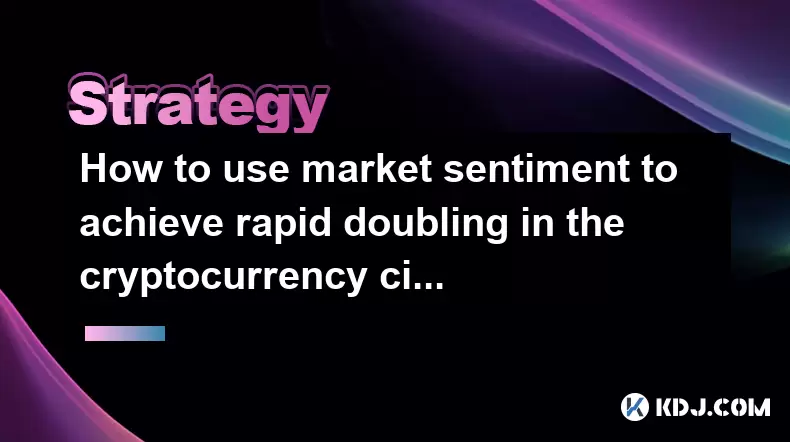-
 bitcoin
bitcoin $87959.907984 USD
1.34% -
 ethereum
ethereum $2920.497338 USD
3.04% -
 tether
tether $0.999775 USD
0.00% -
 xrp
xrp $2.237324 USD
8.12% -
 bnb
bnb $860.243768 USD
0.90% -
 solana
solana $138.089498 USD
5.43% -
 usd-coin
usd-coin $0.999807 USD
0.01% -
 tron
tron $0.272801 USD
-1.53% -
 dogecoin
dogecoin $0.150904 USD
2.96% -
 cardano
cardano $0.421635 USD
1.97% -
 hyperliquid
hyperliquid $32.152445 USD
2.23% -
 bitcoin-cash
bitcoin-cash $533.301069 USD
-1.94% -
 chainlink
chainlink $12.953417 USD
2.68% -
 unus-sed-leo
unus-sed-leo $9.535951 USD
0.73% -
 zcash
zcash $521.483386 USD
-2.87%
How to use market sentiment to achieve rapid doubling in the cryptocurrency circle
Leverage market sentiment in crypto trading by using tools like LunarCrush and CryptoQuant to identify bullish trends and time entries for rapid investment doubling.
May 29, 2025 at 06:35 am

In the fast-paced world of cryptocurrencies, leveraging market sentiment can be a powerful strategy to achieve rapid gains. Market sentiment refers to the overall attitude of investors toward a particular cryptocurrency or the market as a whole. By understanding and reacting to these sentiments, traders can potentially double their investments in a short period. This article will delve into how to use market sentiment effectively to achieve this goal.
Understanding Market Sentiment in Cryptocurrency
Market sentiment is the collective opinion of investors about the future of a cryptocurrency. It can be influenced by various factors, including news, social media trends, regulatory changes, and market performance. In the cryptocurrency circle, sentiment can shift rapidly, making it a critical aspect to monitor for traders looking to double their investments quickly.
To gauge market sentiment, traders often use tools like sentiment analysis, which involves processing data from social media platforms, news articles, and other sources to determine the general mood. Sentiment analysis tools such as LunarCrush and CryptoQuant provide real-time data on how the community feels about specific cryptocurrencies.
Identifying Bullish and Bearish Trends
To use market sentiment effectively, it's crucial to identify whether the market is leaning towards bullish or bearish trends. A bullish market sentiment indicates optimism and a belief that prices will rise, while a bearish sentiment suggests pessimism and a belief that prices will fall.
Traders can identify these trends by monitoring social media platforms like Twitter and Reddit, where discussions about cryptocurrencies are rampant. For instance, if there's a surge in positive posts and tweets about a particular cryptocurrency, it might indicate a bullish trend. Conversely, an increase in negative sentiments could signal a bearish trend.
Using Sentiment to Time Your Entry and Exit
Timing is everything in the cryptocurrency market, and using market sentiment can help traders enter and exit trades at the most advantageous moments. To achieve rapid doubling, traders should look for strong bullish sentiment as an entry point.
- Monitor sentiment analysis tools to identify when sentiment is overwhelmingly positive.
- Look for news events that could further boost sentiment, such as new partnerships or technological advancements.
- Enter the market when sentiment is at its peak, as this is often when prices are about to surge.
For exiting the market, traders should be vigilant for signs of waning bullish sentiment or the onset of bearish sentiment.
- Watch for a decline in positive social media mentions or a shift towards negative comments.
- Set price targets based on historical data and current sentiment levels.
- Exit the market when sentiment begins to turn, as this can signal an impending price drop.
Case Studies of Rapid Doubling Using Sentiment
To illustrate how market sentiment can lead to rapid doubling, let's look at a few case studies.
In 2021, Dogecoin experienced a massive surge in price, largely driven by social media sentiment. Influenced by tweets from high-profile individuals like Elon Musk, the sentiment around Dogecoin became overwhelmingly positive, leading to a rapid increase in its value. Traders who entered the market at the peak of this bullish sentiment and exited before the sentiment waned could have seen their investments double in a matter of days.
Another example is Cardano (ADA), which saw significant price increases in 2021 due to positive sentiment around its technological developments and partnerships. Traders who capitalized on this sentiment were able to achieve rapid gains.
Tools and Platforms for Sentiment Analysis
To effectively use market sentiment, traders need access to reliable tools and platforms. Here are some of the most popular options:
- LunarCrush: This platform provides real-time sentiment analysis based on social media activity. It offers insights into trending cryptocurrencies and the overall sentiment surrounding them.
- CryptoQuant: Known for its on-chain data analysis, CryptoQuant also provides sentiment indicators that can help traders understand market mood.
- CoinGecko: While primarily a price tracking platform, CoinGecko also offers sentiment analysis tools that can be useful for gauging market sentiment.
Strategies for Doubling Your Investment
To achieve rapid doubling using market sentiment, traders can employ several strategies:
- Trend Following: This strategy involves entering the market when sentiment is strongly bullish and exiting when it starts to decline. By following the trend, traders can capitalize on the momentum driven by positive sentiment.
- News Trading: Keeping an eye on news events that could influence sentiment, such as regulatory announcements or technological breakthroughs, can provide opportunities to enter the market at the right time.
- Social Media Monitoring: Actively monitoring social media platforms for shifts in sentiment can help traders stay ahead of the curve. Tools like TweetDeck can be used to set up alerts for specific keywords or hashtags related to cryptocurrencies.
Risks and Considerations
While using market sentiment can lead to rapid doubling, it's important to be aware of the risks involved. Market sentiment can be volatile, and what seems like a strong bullish trend can quickly turn bearish. Additionally, false information and manipulation on social media can lead to misinformed trading decisions.
Traders should always conduct thorough research and not rely solely on sentiment analysis. Combining sentiment data with technical analysis and fundamental analysis can provide a more comprehensive view of the market and help mitigate risks.
Frequently Asked Questions
Q: Can market sentiment be used for long-term investment strategies in cryptocurrencies?A: While market sentiment is most effective for short-term trading due to its volatility, it can also be used to inform long-term investment decisions. By understanding the general sentiment around a cryptocurrency, investors can better assess its potential for long-term growth. However, long-term strategies should also consider other factors like the project's fundamentals and market trends.
Q: How can I avoid falling victim to sentiment-driven market manipulation?A: To avoid falling victim to sentiment-driven manipulation, it's crucial to verify information from multiple sources before making trading decisions. Be wary of sudden spikes in sentiment driven by unverified news or rumors. Additionally, using a combination of sentiment analysis, technical analysis, and fundamental analysis can help you make more informed decisions and reduce the risk of manipulation.
Q: Are there any specific cryptocurrencies that are more influenced by market sentiment?A: Yes, certain cryptocurrencies are more susceptible to market sentiment due to their popularity and community engagement. Meme coins like Dogecoin and Shiba Inu are particularly influenced by social media sentiment. Additionally, newer projects with less established fundamentals may see more volatility driven by sentiment.
Q: How often should I check market sentiment to maximize my trading success?A: The frequency of checking market sentiment depends on your trading style. For day traders and those looking to achieve rapid doubling, checking sentiment multiple times a day can be beneficial. However, for those with a longer-term perspective, checking sentiment daily or weekly might be sufficient. It's important to balance staying informed with avoiding information overload.
Disclaimer:info@kdj.com
The information provided is not trading advice. kdj.com does not assume any responsibility for any investments made based on the information provided in this article. Cryptocurrencies are highly volatile and it is highly recommended that you invest with caution after thorough research!
If you believe that the content used on this website infringes your copyright, please contact us immediately (info@kdj.com) and we will delete it promptly.
- Big City Crypto Buzz: Cross-Chain Bridges, Multi-Chain Horizons, and Presales Paving the Future
- 2025-12-19 21:45:01
- Ray Dalio's Portfolio Prescription: Why Bitcoin and Gold Are Essential in a Debt-Ridden World
- 2025-12-19 01:35:01
- Taiwan's Bitcoin Trove: Criminal Investigations Unearth a Surprising Global Ranking
- 2025-12-19 01:30:02
- Coinbase's Bold Leap: Stocks, Prediction Markets, and the Future of Trading
- 2025-12-19 01:35:01
- Kaito, Kickstarter, and the Post-TGE Crash: Navigating Crypto's Volatile Launch Landscape
- 2025-12-19 01:15:01
- Jito Foundation's Onshoring Signals a New Dawn for Solana and Crypto Regulation in the US
- 2025-12-19 01:25:01
Related knowledge

Why My "Gut Feeling" About Crypto Is Always Wrong.
Dec 07,2025 at 07:00am
Emotional Triggers in Market Participation1. Fear of missing out (FOMO) drives impulsive buys during sharp price surges, often right before a correcti...

How to Build a Crypto Strategy That Works Even When You're Wrong.
Dec 07,2025 at 10:19am
Understanding Market Cycles1. Cryptocurrency markets operate in distinct phases: accumulation, markup, distribution, and markdown. These phases repeat...

Did I Just Buy the Generational Top? A Checklist for Worried Investors.
Dec 17,2025 at 09:19am
Market Sentiment Indicators1. Bitcoin dominance has surged above 55% after a prolonged multi-month decline, signaling capital rotation away from altco...

The "One Last Trade" Fallacy: How to Stop Revenge Trading Your Crypto Losses.
Dec 19,2025 at 10:20am
The Psychology of the Final Attempt1. Traders often believe that one more trade—executed with heightened focus or adjusted parameters—will erase prior...

Why Is It So Easy to Lose Money and So Hard to Make It Back in Crypto?
Dec 19,2025 at 08:19am
Volatility Amplifies Losses1. Cryptocurrency markets routinely experience price swings of 20% or more within a single day, driven by sentiment shifts,...

Escaping the Loop: Buy, It Dips. Sell, It Rips. Here's the Solution.
Dec 14,2025 at 01:40pm
Psychological Traps in Market Timing1. Traders often misinterpret volatility as a signal rather than noise, leading to premature exits during normal r...

Why My "Gut Feeling" About Crypto Is Always Wrong.
Dec 07,2025 at 07:00am
Emotional Triggers in Market Participation1. Fear of missing out (FOMO) drives impulsive buys during sharp price surges, often right before a correcti...

How to Build a Crypto Strategy That Works Even When You're Wrong.
Dec 07,2025 at 10:19am
Understanding Market Cycles1. Cryptocurrency markets operate in distinct phases: accumulation, markup, distribution, and markdown. These phases repeat...

Did I Just Buy the Generational Top? A Checklist for Worried Investors.
Dec 17,2025 at 09:19am
Market Sentiment Indicators1. Bitcoin dominance has surged above 55% after a prolonged multi-month decline, signaling capital rotation away from altco...

The "One Last Trade" Fallacy: How to Stop Revenge Trading Your Crypto Losses.
Dec 19,2025 at 10:20am
The Psychology of the Final Attempt1. Traders often believe that one more trade—executed with heightened focus or adjusted parameters—will erase prior...

Why Is It So Easy to Lose Money and So Hard to Make It Back in Crypto?
Dec 19,2025 at 08:19am
Volatility Amplifies Losses1. Cryptocurrency markets routinely experience price swings of 20% or more within a single day, driven by sentiment shifts,...

Escaping the Loop: Buy, It Dips. Sell, It Rips. Here's the Solution.
Dec 14,2025 at 01:40pm
Psychological Traps in Market Timing1. Traders often misinterpret volatility as a signal rather than noise, leading to premature exits during normal r...
See all articles









































































